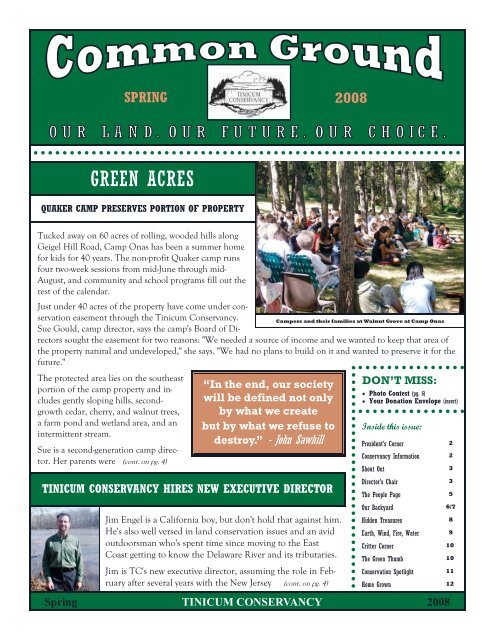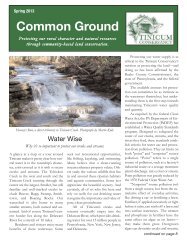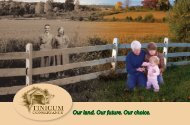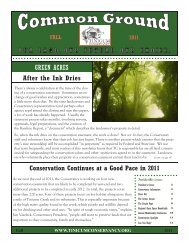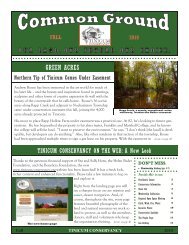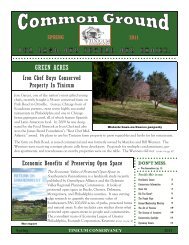Newsletter-Spring '08-FINAL to printer3-6-08 - Tinicum Conservancy
Newsletter-Spring '08-FINAL to printer3-6-08 - Tinicum Conservancy
Newsletter-Spring '08-FINAL to printer3-6-08 - Tinicum Conservancy
Create successful ePaper yourself
Turn your PDF publications into a flip-book with our unique Google optimized e-Paper software.
SPRING 20<strong>08</strong>ACRESGREEN ACRESQUAKER CAMP PRESERVESPORTION OF PROPERTYQUAKER CAMP PRESERVES PORTION OF PROPERTYTucked away on 60 acres of rolling, wooded hills alongGeigel Hill Road, Camp Onas has been a summer homefor kids for 40 years. The non-profit Quaker camp runsfour two-week sessions from mid-June through mid-August, and community and school programs fill out therest of the calendar.Just under 40 acres of the property have come under conservationeasement through the <strong>Tinicum</strong> <strong>Conservancy</strong>.Campers and their families at Walnut Grove at Camp OnasSue Gould, camp direc<strong>to</strong>r, says the camp's Board of Direc<strong>to</strong>rssought the easement for two reasons: "We needed a source of income and we wanted <strong>to</strong> keep that area ofthe property natural and undeveloped," she says. "We had no plans <strong>to</strong> build on it and wanted <strong>to</strong> preserve it for thefuture."The protected area lies on the southeastportion of the camp property and includesgently sloping hills, secondgrowthcedar, cherry, and walnut trees,a farm pond and wetland area, and anintermittent stream.Sue is a second-generation camp direc<strong>to</strong>r.Her parents were (cont. on pg. 4)“In the end, our societywill be defined not onlyby what we createbut by what we refuse <strong>to</strong>destroy.” - John SawhillTINICUM CONSERVANCY HIRES NEW EXECUTIVE DIRECTORJim Engel is a California boy, but don't hold that against him.He's also well versed in land conservation issues and an avidoutdoorsman who's spent time since moving <strong>to</strong> the EastCoast getting <strong>to</strong> know the Delaware River and its tributaries.Jim is TC's new executive direc<strong>to</strong>r, assuming the role in Februaryafter several years with the New Jersey (cont. on pg. 4)DON’T MISS:• Pho<strong>to</strong> Contest (pg. 6)• Your Donation Envelope (insert)Inside this issue:President’s Corner 2<strong>Conservancy</strong> Information 2Shout Out 3Direc<strong>to</strong>r’s Chair 3The People Page 5Our Backyard 6/7Hidden Treasures 8Earth, Wind, Fire, Water 9Critter Corner 10The Green Thumb 10Conservation Spotlight 11Home Grown 12<strong>Spring</strong> TINICUM CONSERVANCY 20<strong>08</strong>
Your <strong>Conservancy</strong> could notfunction without its volunteers.The Executive Direc<strong>to</strong>r and Trusteeswould like <strong>to</strong> thank the followingpeople for their recent gifts of time.SHOUT OUTMartie Kyde – for 15 years of service <strong>to</strong> TC.Martie left the board in January. Her manycontributions include chairing the ConservationPrograms, grant writing, baseline informationgathering, Land Preservation Committeemember, newsletter writing, and anyother tasks that needed doing. TC will missMartie greatly.Ron Novak – for six very active yearson the board. Ron spent countless hoursworking on easement drafting, developingand updating the TC Board Manual,and chairing the Land PreservationCommittee. Ron held TC <strong>to</strong> the higheststandards of land protection and stewardship.His work will guide TC foryears <strong>to</strong> come.Graham and Beverly Place and BoyceBudd – for all their work setting up and tearingdown booths for the September BlockParty. Beverly also chaired the bake table, abig job. Other important volunteers wereStana Lennox, John Moore, Rob Morrison,June Rothkopf, Pat Whitacre, BetsyJacobs, Diane and Dave Allison, Joe Billinghamand Nancy and Rachel Shaffran.Maureen Santina designed the creative brochurefor the Block Party.Doug Sardo – for a donation of severalpieces of his artwork <strong>to</strong> TC.Mark Manchester – for helping KrisBecker and Betsi Campbell print names andaddresses directly on<strong>to</strong> the postcards announcingTC’s grassland bird program onMarch 2. Mark’s computer expertise andmailings experience were an enormous help!Ann Ballantine – for the wonderful drawingon the postcard for the grassland bird program.Todd Quinby – for his willingness <strong>to</strong> plowthe S<strong>to</strong>ver Mill parking lot in the event ofsnow.THE DIRECTOR’S CHAIRMembers and Friends:At the end of January, we said good-bye <strong>to</strong>Kathi Throckmor<strong>to</strong>n. Although Kathi was executivedirec<strong>to</strong>r of the <strong>Tinicum</strong> <strong>Conservancy</strong>for only a little less than two years, her rolewas a very important one. Under her guidancethe <strong>Conservancy</strong> made the transition from beingan all-volunteer land trust <strong>to</strong> one with afull-time executive direc<strong>to</strong>r, a part-time accountant,and plans in place for a part-time administrativeassistant.DID YOU KNOW?A recent survey of 75 landtrusts in Pennsylvaniashows that the <strong>Tinicum</strong><strong>Conservancy</strong> rates 14th inthe number of acresunder easement.Kathi coordinated thechallenging task of settingup the <strong>Conservancy</strong>’s firstpermanent office at theS<strong>to</strong>ver Mill, with advancedtechnology generouslyprovided by grantmoney. She developed excellentvolunteer teams <strong>to</strong> create a first-ratenewsletter, an improved membership program,a database inven<strong>to</strong>ry, and remote access <strong>to</strong> <strong>Conservancy</strong>files.At a time when land trusts all over the countryare under pressure <strong>to</strong> meet ever higher standards,Kathi made certain that the <strong>Tinicum</strong><strong>Conservancy</strong> can meet increased IRS scrutiny.She adapted the new Pennsylvania Land TrustAssociation conservation easement document <strong>to</strong>the needs of <strong>Tinicum</strong> landowners. Most important,the <strong>Conservancy</strong>’s land preservation workcontinues at an impressive pace.We thank Kathi for her hard work and wishher success in the future. For an introduction<strong>to</strong> our new executive direc<strong>to</strong>r, Jim Engel, aswell as new board member, Diane Allison, seethe related articles on pages one and five.Karen Budd<strong>Spring</strong> 20<strong>08</strong> TINICUM CONSERVANCY Page 3
camp direc<strong>to</strong>rs after Onas moved <strong>to</strong> <strong>Tinicum</strong> Township from its original location in Rushland,Pa., in the mid-1960s. She and her siblings all attended the camp and were camp counselors. As anadult, she returned as the summer direc<strong>to</strong>r and became the full-time direc<strong>to</strong>r in 1995. She and herhusband, David, live at the camp year-round. (Onas means "quill" in Lenape and is the name given<strong>to</strong> William Penn by the Native Americans.)Sue's camp saga is repeated in the campers themselves. Eighty percent of them return year afteryear, and when they are <strong>to</strong>o old <strong>to</strong> attend—the camp is for 8- <strong>to</strong> 13-year-olds—they often return ascamp aids and counselors.Onas is a traditional summer overnight camp, with sports, games, canoeing on the pond, natureprograms, drama workshops, music performances, and arts/crafts. Campers also learn about animal care by tending <strong>to</strong> the donkeysPaco and Pepita, a pot-bellied pig named Puddy, and a golden retriever named Ellie. They compost all lef<strong>to</strong>ver food and animalwaste, enriching the soil in the camp garden and other areas.Happy campersGREEN ACRES (cont. from pg. 1)Part of the 40 acres undereasement at Camp OnasMany of the 400 campers each season come from surrounding Bucks County and Delaware Valley <strong>to</strong>wns,but others are from farther flung areas: New York, Maryland, Virginia, Florida, and California. A few evenmake the trip from overseas.In the spring and fall, the camp is host <strong>to</strong> various school groups for three-day overnight outdoor educationprograms. <strong>Tinicum</strong> Elementary uses the camp every year for its fifth grade graduation party, and a schoolin Bath, Pa., brings students for an annual challenge day. On winter weekends, civic, religious, and nonprofitgroups come for retreats.- Article by Dianna Sinovic/Pho<strong>to</strong>s by Camp Onas(cont. from pg. 1) Conservation Foundation and the Nature<strong>Conservancy</strong>. He brings excellent experience <strong>to</strong> TC's land preservationefforts. As executive direc<strong>to</strong>r of the Ojai Valley Land<strong>Conservancy</strong> in California, he helped <strong>to</strong> transform that organization from a one-person staff and a$45,000 budget <strong>to</strong> a six-member staff and a $475,000 budget within just seven years. “I learned how<strong>to</strong> take an organization with a worthy mission and convert it <strong>to</strong> a group with a solid his<strong>to</strong>ry of resultsand a large and diverse group of supporters,” he says.TC Hires New Exec. Direc<strong>to</strong>rJim grew up in Malibu—back before it became the trendy celebrity enclave. His parents built their own house on property betweenthe mountains and the beach and instilled a love of nature and the outdoors that led <strong>to</strong> his choice of careers. "I've always had apassion for the natural world," Jim says. After graduating from Colorado State University with a degree in park management, hestarted out developing and directing programs in environmental education at nature centers in Southern California. He even builta nature center from scratch in Fontana, Calif. When he started at that site, he says, "There was just a building with nothing in itand no landscaping."He became the expert who helped environmental organizations grow through fund-raising and strategic planning. As a consultant,he worked with small groups across the West, from Idaho <strong>to</strong> New Mexico. But consulting, though enjoyable, didn't allow him <strong>to</strong>see the final outcome of his projects, so he decided <strong>to</strong> switch <strong>to</strong> land conservation. "That," he says, "was absolutely my niche." Thedirec<strong>to</strong>r's job in Ojai allowed him <strong>to</strong> tap in<strong>to</strong> the many fields of expertise he'd developed over the years: fund-raising, education,administration, and program management. He takes special pride in his ability <strong>to</strong> create successful partnerships with farmers, otherlandowners, and government representatives.“I conceive that the landbelongs <strong>to</strong> a vast familyof which many are dead,few are living,and countless numbersare still unborn.”- Author Unknown“Don’t blow it -good planetsare hard <strong>to</strong> find.”- quoted in TimeJim and his wife, Dawn, and their 4-year-old daughter live in Morris County, N.J., on 2-1/2 acres just over the border from Hunterdon County. Their property is surrounded byseveral thousand acres of preserved farmland.Although he's still getting settled in<strong>to</strong> his new post, Jim has several goals in mind at TC.He looks forward <strong>to</strong> getting out in<strong>to</strong> the community and working with the people of<strong>Tinicum</strong> Township and neighboring communities. "I want <strong>to</strong> reach out <strong>to</strong> landownersand continue the great momentum of land protection in the <strong>to</strong>wnship," he says. He's alsolooking <strong>to</strong> build the financial capacity of TC <strong>to</strong> meet future opportunities.We are glad <strong>to</strong> have you, Jim!- Article by Karen Budd and Dianna Sinovic /Pho<strong>to</strong> by Karen BuddPage 4 TINICUM CONSERVANCY <strong>Spring</strong> 20<strong>08</strong>
THE PEOPLE PAGETRUSTEE SPOTLIGHT: Jim VaseleckJim Vaseleck freely admits that he's one of the few TC trustees who doesn't have his landunder conservation easement. "But that's because it doesn't qualify," he says with achuckle. "Two of the three acres are palisades." Jim and his partner, Hank Cochran, livealong the Delaware Canal in Uhlers<strong>to</strong>wn, in Mike Uhler's former boat shop, which hasbeen converted in<strong>to</strong> a comfortable home. He's been a TC trustee since 2004, when hefilled a position vacated by a resignation. He's now in his last year of a full three-year term.“There are nopassengers onSpaceship Earth.We are all crew.”Jim, an at<strong>to</strong>rney who works for the Law School Admission Council, initially wanted <strong>to</strong> joinone of the <strong>to</strong>wnship's committees, but after attending a <strong>to</strong>wnship meeting, changed his mind."I decided I didn't want <strong>to</strong> be on any of them," he remembers. But he couldn't get away soeasily. Township Supervisor Boyce Budd called <strong>to</strong> suggest he consider the <strong>Conservancy</strong> as analternative group with which <strong>to</strong> volunteer his time. After meeting with Budd's wife, Karen,TC president, Jim joined up.- Marshall McLuhanJim loves the rural flavor and natural beauty of the <strong>to</strong>wnship, which he's called home for 11years. "But it's not just pretty," he says. "There are ecological values I wasn't aware of." He was surprised, for instance, atthe number and quality of watersheds in the area.The house on the canal is Jim's second since moving <strong>to</strong> the area from New Hope. He and Hank first lived at Bridge Fivealong River Road. "The first house we looked at here was ideal," he says. "That's what brought us here." And when theyoutgrew that first house, they didn't think of moving away from <strong>Tinicum</strong>. "We liked it so much, we decided <strong>to</strong> stay."Several years ago, while wandering through an antique show, he was delighted <strong>to</strong> find a 1920s era painting of his canalhouse—back when it was a working boathouse. "I thought it looked familiar," he says. "Then I realized it was my house."- Article by Dianna Sinovic/Pho<strong>to</strong> by John KalninDiane Allison figures she's built roughly 2,000 bluebirdboxes with school groups and scout troops over the years—TRUSTEE SPOTLIGHT: Diane Allisonenough boxes <strong>to</strong> earn her the nickname the Bluebird Lady.But although bluebirds have been her focus, she's an avidbirder of all species, regularly compiling lists for several annual bird counts in the area. Her interest in birds is just oneaspect of a larger concern for the environment and a longstanding support of the <strong>Tinicum</strong> <strong>Conservancy</strong>."I've been supportive of the mission forever," says Diane, one of several new TCboard members who <strong>to</strong>ok their posts in January. She and her husband, Dave, own "So bleak is the picture...a hybrid car and have converted the heating/cooling system in their home <strong>to</strong> geothermal.Their land has been under conservation easement since 2004. Theirthat the bulldozer andnot the a<strong>to</strong>mic bombeight acres is scattered with not only bluebird boxes, but other birdhouses and batboxes, as well. They are also encouraging part of the property <strong>to</strong> revert back <strong>to</strong> may turn out <strong>to</strong> beforest. "It's not a huge property," she says, "but we really felt that it was important the most destructive<strong>to</strong> support the concept of conservation easements."invention of theShe remembers what tipped her resolve <strong>to</strong> protecttheir small patch of land. "I read one day about a 20th century.”piece of property in Perkasie," she says. "It was eight - Philip Shabecoff,acres, and they were talking about 195 units. I read New York Times Magazinethat and I thought, 'You know what, eight acresisn't so small—in terms of the impact it could have if it were developed <strong>to</strong> the max." As itturned out, a decision helped spark neighbors <strong>to</strong> follow suit. "It's actually turned in<strong>to</strong> apretty good little enclave of conserved properties," she says of their corner (cont. on pg. 8)<strong>Spring</strong> 20<strong>08</strong> TINICUM CONSERVANCY Page 5
OUR BAC“Little Fox in Flowers”Pho<strong>to</strong> by Maureen SantinaCORRECTION:We wish <strong>to</strong> apologize for themisspelling of the last names of twoof the talented pho<strong>to</strong> contribu<strong>to</strong>rs<strong>to</strong> our last issue: Maureen Santina(not Santini) and Joan Carter(not Campbell).“Kitten Discovers Deer”Pho<strong>to</strong> by Lou PomanteCRITTERSHere's another installment of Commwith pictures provided by you—our reon the wildlife that live in the yards<strong>Tinicum</strong> Township. Thanks <strong>to</strong> all wwhether furry or featheAre you ready for a new challenge? Twill highlight a special <strong>to</strong>wnship resoupho<strong>to</strong>s of children in nature. WeEmail low resolution files <strong>to</strong>: pictureask for higher resolution pixs for prfavorite snaps <strong>to</strong> <strong>Tinicum</strong> ConservaPA 18920 (if you send a stamped, secan’t guarantee, <strong>to</strong> return yo“Horse Heaven”Pho<strong>to</strong> by Lisa Hossler“A Very Happy Pig at Purely Farm”Pho<strong>to</strong> by Martie Kyde“SnowPho<strong>to</strong> by Kat“Rainbow”Pho<strong>to</strong> by Maureen Santina“Baby Snorkel Makes Her Debut”Pho<strong>to</strong> by Kris Becker“The earth we abuseand the living things we killwill, in the end,take their revenge;for in exploiting their presencewe are diminishing our future.”- Marya Mannes“Monarch Caterpillars”Pho<strong>to</strong> by Joan CarterPho<strong>to</strong>“Contestant at the <strong>Tinicum</strong> Park Dog Show”Pho<strong>to</strong> by Kris BeckerPage 6HELP PRESERVE THIS BEAUTY FOR FUTURE GENERATTINICUM CO
K YARDGALORE !on Ground's popular pho<strong>to</strong> gallery,adership. This pho<strong>to</strong> edition focuses, woods, streams, and meadows ofho shared their "neighbors" with us,red, crawling or flying.he Fall edition of Common Groundrce: its children. Please send us your'll try <strong>to</strong> fit in as many as we cans@<strong>Tinicum</strong><strong>Conservancy</strong>.org (we mayinting purposes) or snailmail yourncy/Pho<strong>to</strong>s, PO Box 206, Erwinna,lf-addressed envelope we will try, butur hardcopy submissions).“A Local Resident”Pho<strong>to</strong> by Maureen Santina“Clydesdale Wanna Be”Pho<strong>to</strong> by Maureen Santina“Our time is so short,and the future so terrifyingly long.Through the art of brush, pen andlens … we possess a swift and suremeans of <strong>to</strong>uching the conscienceand clearing the vision.”- Ansel Adams“Avian Visi<strong>to</strong>rs: Black Vultures”Pho<strong>to</strong> by Martie KydeGeese”hleen Connally“Chicken Dance”Pho<strong>to</strong> by Kathleen Connally“Puppy Love”Pho<strong>to</strong> by Lisa Hossler“Creating a Flap”Pho<strong>to</strong> by Maureen Santina“Smile”“Monarch Butterfly”“Strolling on River Road”by Kathleen FisherPho<strong>to</strong> by Maureen SantinaPho<strong>to</strong> by Maureen SantinaIONS. RENEW YOUR MEMBERSHIP OR JOIN TODAY.“Benjamin”Pho<strong>to</strong> by Stu HornNSERVANCY Page 7
HIDDEN TREASURESWhen you drive past the small white chapel onGeigel Hill Road, you are seeing a building thatis partly yours. Rock Ridge Chapel, built in1847, is part of the <strong>Tinicum</strong> community. The chapel has a devoted group of trustees andcaretakers who follow in the footsteps of many <strong>to</strong>wnship residents who have cherished thechapel, worshiped there, and sometimes held oyster suppers and strawberry festivals <strong>to</strong> raisemoney <strong>to</strong> fix the roof and windows.Winter chapelThe 2.7-acre Rock Ridge property was originally part of a 204-acre tract. The first deed forthat tract is dated April 15, 1794, and shows a transfer from the “London Company Tract”and the estate of George Bryan, Esq., <strong>to</strong> David Fox. The chapel was erected 53 years later, and on Sundays, as many as 250congregants crowded in <strong>to</strong> hear the service. When the chapel's preacher, the Rev. S.S. Diehl, died in 1924 after 33 years in thepulpit, the congregation diminished and the chapel fell in<strong>to</strong> disuse. An attempt <strong>to</strong> revive the chapel in 1955 did not succeed.The <strong>Tinicum</strong> Civic Association came <strong>to</strong> the rescue of the neglected building in 1972 by paying $295 in back taxes. NeighborsJohn Quinby, Carl Damm, and Vic Meierdierck donated time and talent <strong>to</strong> prepare the building for a Thanksgiving Eveservice that year led by Dr. Robert Perry, father of <strong>Tinicum</strong> resident Ethan Perry. John Quinby remembers that many otherswere part of the cleanup brigade, including Bill and Anne Bickel and Joanne Blessing. John hadjust returned from hunting in Maine when he joined the roof repair crew. The scaffolding gaveway and John slipped off the roof, landing on nearby rocks and was laid up for three months.Interior viewToday the chapel is the setting for three annual nondenominational services—on ThanksgivingEve, Christmas Eve, and at Easter sunrise. Trustee Joanne Hamil<strong>to</strong>n is one of the enthusiasticgroup that promotes the chapel for weddings, memorial services, and showers. Contact Joanne at610-847-2906. - Article by Peggy Enoch/Pho<strong>to</strong>s by Kathleen Connally(cont. from pg. 5) of Hollow Horn and Ervin roads.Trustee Spotlight: Diane AllisonAs a board member, Diane is overseeing the Conservation Spotlight programs, hoping<strong>to</strong> bring in more participants by sending out postcards <strong>to</strong> all <strong>to</strong>wnship residents. <strong>Tinicum</strong> artist Anne Ballantine did the artworkfor the first postcard—an Eastern meadowlark bursting with song—<strong>to</strong> promote the March program on grassland birds. "Byadvertising more, we may attract new members," Diane says. Among the programs scheduled for this year is a possible latesummer field trip <strong>to</strong> look at area hedgerows.A resident of <strong>Tinicum</strong> for 30 years, Diane had been asked several times <strong>to</strong> join the TC board, but other commitments kepther from accepting. This time the timing was right. Herinvolvement in birding dovetails nicely with the <strong>Conservancy</strong>'swork, she says. "Birding is a great partner with conservation.Birds are 'the canary in the coal mine.' Whenthe bird population starts changing, you know somethingis changing in the environment." She points <strong>to</strong> the ruffedgrouse as an example. The grouse, once plentiful in thearea, is no longer found here, because the birds need forestunders<strong>to</strong>ry for their habitat, and much of the unders<strong>to</strong>ryhas been eaten by the large population of white-taileddeer.“Man has been endowed with reason,with the power <strong>to</strong> create,so that he can add <strong>to</strong> what he's been given.But up <strong>to</strong> now he hasn't been a crea<strong>to</strong>r,only a destroyer.Forests keep disappearing,rivers dry up, wild life's become extinct,the climate's ruined and the landgrows poorer and uglier every day.”- An<strong>to</strong>n ChekhovA dedicated outdoor enthusiast, Diane, who works inmicrobiological quality assurance for Johnson & Johnson,has added biking <strong>to</strong> her list of activities. About a year ago,she and her husband started biking, in part so Dave could lose weight. When 25 pounds melted off over several months ofriding, he decided on another challenge: an annual charity ride at the Shore for multiple sclerosis. "We signed up for the 45-miler because we didn't know how hard it would be or how good a shape we would be in," she says. Their rigorous training onthe hills of <strong>Tinicum</strong> made the 45 flat miles at the Shore a breeze. "As it turns out, we could have done 75 miles."- Article by Dianna Sinovic/Pho<strong>to</strong> by Dave AllisonPage 8 TINICUM CONSERVANCY <strong>Spring</strong> 20<strong>08</strong>
EARTHDid you know that thehedgerows that borderfields are of greatecological importance? Itis called the “edge effect”— where there is greaterdiversity of species thancan be found singly inwoods or field. Hedgerows provide food and shelter for manydifferent forms of wildlife: butterflies and other insects, birds,voles, mice, foxes, hares, and weasels. Shelter comes from theundergrowth of shrubs and brambles interspersed with smalltrees, rotting logs for insects, and leaf mold for rodents.Abandoned birds’ nests become winter habitat for mice.Birdlife in hedgerows can be prolific. Indigo buntings nest inthe tangle of raspberry and blackberry briers. Robins, thrushes,and vireos use the thick branches of the dogwood tree, andgreenbrier attracts cardinals, mockingbirds, thrashers, andcatbirds.To learn more about how you can make your hedgerowsprovide habitat for wildlife, come <strong>to</strong> the <strong>Tinicum</strong> <strong>Conservancy</strong>program on hedgerows, given by David Hughes of FringetreeDesign, scheduled for Saturday, August 9. Check our websitefor more details.– Article by Karen Budd/Pho<strong>to</strong> by Kathleen ConnallyFIREWINDFor centuries people haveattempted <strong>to</strong> tap in<strong>to</strong> the free andmighty power of the wind. Itsmercurial nature, though, hasmade inventions like thewindmill helpful but unreliableenergy partners. Now there isnew hope on the horizon. InDecember, the New York TimesMagazine published its “7 thAnnual Year in Ideas” issue, in which it looks back on the“curious, inspired, perplexing, and sometimes outright illegalinnovations” of the past 12 months. One such featured itemwas “airborne wind turbines.” Taking advantage of the constantbreeze blowing at 1,000 feet up, Magenn Power has developeda lighter-than-air wind turbine capable of powering an entirevillage. Other earth-friendly ideas in this issue, such as “biodegradablecoffins,” may provoke controversy but certainlygive food for thought <strong>to</strong> anyone who looks <strong>to</strong> leave a smallerfootprint on our planet.To read more about wind turbines and other intriguinginventions, go <strong>to</strong>: http://www.nytimes.com/2007/12/09/magazine/09_1_turbine.html?ref=magazineWATER– Article by Kris BeckerWho doesn’t remember the delicious smell of burning leaves asone of childhood’s wonderful experiences? The aroma of woodsmoke still engages our senses in a delightful way. To combatthe growing problem of air pollution and related healthproblems, though, we must understand the reality of the effec<strong>to</strong>f smoke on air quality. The Department of EnvironmentalProtection publishes a fact sheet on Open Burning ofResidential Trash in Pennsylvania (2700-FS-2492 Rev.2/2007), which encourages citizens <strong>to</strong> consider alternatives <strong>to</strong>burning. “Because of the potential health and fire risks <strong>to</strong> openburning, DEP strongly recommends that you recycle and reuseas much of your trash as possible or take it <strong>to</strong> a licensed landfillor municipal incinera<strong>to</strong>r,” the fact sheet says. Open burning of“household waste” is not regulated by the DEP if the waste is“domestic refuse” and the burning occurs at private residenceswhere not more than two families are living. Items notconsidered “domestic refuse” include demolition waste,insulation, shingles, treated wood, paint, painted or stainedobjects or furniture, tires, mattresses, box springs, metal,insulating coating on wire, television sets and appliances,au<strong>to</strong>mobiles, au<strong>to</strong>motive parts, batteries, PVC products, andwaste oil and other petroleum products.Let’s care for our air: Reduce, recycle, andreuse.- Article by Peggy Enoch/Pho<strong>to</strong> byKathleen ConnallyWhat is a watershed? You’re sitting in a watershed now. It’sthe area of land that catches rain and snow and drains in<strong>to</strong> amarsh, stream, river, lake, or groundwater. Homes, farms,forests, small <strong>to</strong>wns, and big cities make up watersheds. Someare millions of square miles; others are just a few acres. Just ascreeks drain in<strong>to</strong> rivers, watersheds are nearly always part of alarger watershed. Virtually every stream, lake, river, andaquifer in this country is used as a drinking water source.Protecting source waters from contaminants is a major nationalpriority <strong>to</strong> protect public health by ensuring a clean, safedrinking water supply, especially if you have a well.Creating and maintaining a masterpiece of a lawn requires asignificant amount of chemicals and water. Runoff from a lawnsprinkler can wash lawn chemicals, pet waste, and otherpollutants directly in<strong>to</strong> watersheds; the residue of soap and waxfrom washing your car has a similar effect.Go <strong>to</strong>:www.conservationinformation.orgYou can enter your ZIP code, seeyour watershed, and find moreinformation on what you can do <strong>to</strong>protect it.– Article by Betsi CampbellBucks County watershed in red<strong>Spring</strong> 20<strong>08</strong> TINICUM CONSERVANCY Page 9
On mornings in mid-May, when <strong>Tinicum</strong> is alive withbird song, you may be fortunate enough <strong>to</strong> hear therolling, bubbling, R2-D2-like sound of the bobolink,one of Pennsylvania’s more uncommonbirds. Easily identified by sight as wellas song, the bobolink is North America’sonly bird that is black underneathand white on the back. Each spring thebobolink migrates 6,000 miles fromArgentina <strong>to</strong> breed in grasslands of theUnited States and Canada.Bobolink<strong>Tinicum</strong>’s hayfields and meadows arehome <strong>to</strong> a number of species of grassland birds in addition<strong>to</strong> the bobolink. Many of these, such as theeastern meadowlark, grasshopper sparrow, and savannahsparrow, are considered of “special conservationconcern” by the Pennsylvania Game Commission andconservation organizations like Partners in Flight. Inthe Eastern UnitedStates, grasslandbird populationshave declined 80percent in the last25 years primarilybecause of development-relatedloss ofhabitat. EvenCRITTER CORNERGRASSLAND BIRDS“Suburbiais where the developerbulldozes out the trees,then names the streetsafter them.”- Bill Vaughnamong remaining fields, these species face increasingpressures because of earlier and closer hay-cropping. Inaddition <strong>to</strong> providing habitat for these birds of springand summer, meadows and hayfields serve as winterfeeding grounds for other species of concern includingthe northern harrier (marsh hawk) and the endangeredshort-eared owl.One way <strong>to</strong> help maintain these declining contribu<strong>to</strong>rs<strong>to</strong> <strong>Tinicum</strong>’s biodiversity is <strong>to</strong> delay the initial mowingof hayfields until mid-July, after the first set of younghave fledged, and eliminate late season mowing, whichallows more standing vegetation for winter residents.Information on the grassland species that nest in <strong>Tinicum</strong>is available online at www.birds.cornell.edu/AllAboutBirds. This site even allows you <strong>to</strong> listen <strong>to</strong>each species’ song. That way, as you take a few moments<strong>to</strong> appreciate the beauty of <strong>Tinicum</strong> this spring,you can key in on those uncommon grassland birds.—Article by Jeff KellerTHE GREEN THUMBMAKING A MEADOWA growing number of people, including many withonly a few acres of property, are converting lawn orlittle used agricultural land <strong>to</strong> meadow. The reasonsoften have <strong>to</strong> do with lower maintenance costs—it cancost $1,000 per acre per year <strong>to</strong> maintain a wellmanicured,lush-looking lawn. Besides saving moneyand reducing air and water pollution, and gasolineconsumption, some residents enjoy the grasses andwildflowers that can be introduced, as well as the butterfliesthat follow.Should you decide <strong>to</strong> naturalize a portion of yourproperty, the first thing <strong>to</strong> decide is “what am I managingfor?” Aesthetics? Butterflies? Grassland birds?Cost savings? If it’s the last, you may choose just <strong>to</strong>mow some areas away from your house less often. Ifyour motivation is something else, then what youplant will depend on your goals.You can find information on websites of seed supplierslike Ernst Conservation Seeds and Prairie Nurserythat will guide you through the steps of preparing aseed bed, seeding, and establishing a meadow. If aestheticsand butterflies are your goals, a mix of perennialnative grasses and wildflowers works best. Be sure<strong>to</strong> include native cool season grasses <strong>to</strong> get somegreen in the spring and fall. Cool season grasses areadapted <strong>to</strong> grow in the cooler months at the beginningand end of the growing season. For staying greenin the heat of the summer and beautiful in fall color,native warm season grasses (WSGs) are a good choice.Be aware that some WSGs grow <strong>to</strong> 4 <strong>to</strong> 7 feet. So,you may want <strong>to</strong> use these away from the house, if atall. Also, be aware that many nativewildflowers are eagerly eaten by deer.Therefore, you may want <strong>to</strong> plant wildflowersin limited areas where you caneasily see them, as well as spray themwith deer repellent. Check with suppliersfor recommendations on less deerpalatablespecies.Because of the overabundance of deer,it is difficult <strong>to</strong> create and maintain aNorthernHarriernative meadow with a balance of grasses and wildflowerssuitable for breeding grassland birds. Deer don’teat WSGs, and thus these grasses come <strong>to</strong> dominatemany native meadows. The result, although oftenattractive, is a meadow that develops <strong>to</strong>o late in thebreeding season <strong>to</strong> be used for nesting (cont. on pg. 11)Page 10 TINICUM CONSERVANCY <strong>Spring</strong> 20<strong>08</strong>
CONSERVATION SPOTLIGHT: Roaring Rocks/Swamp CreekNineteen special birds! Marbled salamanders! Pollution-sensitive creek critters! Rare and endangeredplants! Thirteen vernal pools! This little 2,500-acre watershed has them all.Scientists contracted by the <strong>Conservancy</strong> under a Wild Resources Conservation Program grant havecompleted their biodiversity research in this corner of the Pennsylvania Highlands, bordered by Upper<strong>Tinicum</strong> Church, Swamp Creek, and Permanent School roads. Thanks <strong>to</strong> Drs. Ann Rhoads and TimBlock, Marlin Korn, Phil Perhamus, Scott Grossman, Devich Farbotnik, and Dr. Marion Kyde for thefield research; <strong>to</strong> Diane Rosenkrantz for the mapping, and <strong>to</strong> Suzanne Forbes for background and compilation. A copy of thereport is available in the TC office.Three hundred sixty-seven plant species, including the rare water pimpernel and heath aster, form the plant communities.Eighty percent are native (63 percent is the state average). The stream itself supports all three classes of pollution-sensitiveinsects – mayflies, caddisflies, and s<strong>to</strong>neflies – and its water quality is excellent. Snakes, frogs, and salamanders are wellrepresented (25 species), including the endangered marbledUPCOMING EVENTSThe <strong>Tinicum</strong> <strong>Conservancy</strong> is sponsoring another year ofConservation Spotlight Programs, highlighting some ofthe reasons for the <strong>Conservancy</strong>’spreservation efforts. Please join us!1 p.m. April 27: "Sheep <strong>to</strong> Shawl"Marlene Halstead will discuss woolproduction, harvesting the wool, andthe use of the wool <strong>to</strong> create products.Marlene will show us her method for shearingsheep, and participants will be able <strong>to</strong> give it a try!Dress accordingly, and carpool if possible. Limit: 20people. To register, call Diane Allison, 610-847-2<strong>08</strong>5.10 a.m. June 7: "Lenape Lands"Shelley DePaul will lead this programon a conserved property that was oncea Lenape campground. Shelley willbring us closer <strong>to</strong> the Lenape with adrumming demonstration and s<strong>to</strong>riesfrom the Lenape tradition. It's a wonderful mix of placeand culture, so don’t miss this exciting window in<strong>to</strong> theLenape way of life. For meeting location/information,call Diane Allison, 610-847-2<strong>08</strong>5.10 a.m. August 9: "Hedgerows - An Icon of BucksCounty's Rural Vernacular Landscape"David Hughes of Fringetree DesignStudios, LLC, will share some ofhis observations on how hedgerowswere created, what native speciesare common <strong>to</strong> them, and what invasivespecies threaten our hedgerows.He will also discuss thefunctions and ecological values that existing hedgerowsprovide and offer some thoughts on how <strong>to</strong> best preservethese unique landscape features. David will drawon local and regional examples <strong>to</strong> show the splendor ofour hedgerows. Program at Christ Lutheran Church, 353E. Dark Hollow Rd., Pipersville. For more information,call Diane Allison, 610-847-2<strong>08</strong>5.Marbled salamandersalamander, whose habitat is disappearing across its his<strong>to</strong>ric range.Baby box turtles indicate that reproduction is healthy here; boxturtles are in trouble in many parts of the state. One hundredeleven bird species nest in the canopy and unders<strong>to</strong>ry. Nineteen ofthese are species for which Pennsylvania has a special responsibility;several are on the threatened/endangered list. Three uncommonbats – long-eared, hoary, and Eastern red – all of greatestconservation concern and legally protected in the state, live here.Black bears and bobcats utilize the watershed, along with numeroussmaller mammals. The list of over 80 mushrooms reflects therichness of the tree community.Copies of the report with its management recommendations havebeen given <strong>to</strong> the <strong>to</strong>wnship and the county, and <strong>to</strong> all thelandowners who allowed our scientists access. TC thanks NormMacArthur, Bill Novak, Stuart Louden, Richard and MadelineZaveta, Les Schuman, Mark and Joan Stevens, Boyce and KarenBudd, and Tary Leonard (the Ruttenberg property) for theirgenerous cooperation with the research team. To view the fullreport, go <strong>to</strong>: www.buckscountyherald.com/BCH links- Article by Marion Kyde/Pho<strong>to</strong> by Marlin Corn(cont. from pg. 10) by grassland birds.THE GREEN THUMBIf you have five or more acres notalready being managed for hay and wish <strong>to</strong> encourage these uncommonbirds, plant a traditional commercial “hay” mix fromAgway. The combination of old world cool season grasses plusalfalfa in these mixes works well for most of the grassland birdsin our region, and still allows for late season hay cropping. Leavinga meadow standing through the winter helps provide habitatfor a variety of wildlife.If you only mow annually, mow the meadow in late winterwhile the ground is still firm enough for mowing equipment orwait until late April, when the soil dries out a bit, but beforebirds begin nesting.Jeff Keller has a doc<strong>to</strong>rate in wildlife ecology from Cornell University and works asa res<strong>to</strong>ration ecologist. He has designed and installed hundreds of acres of nativemeadow for public and private interests. Jeff serves on TC's Board of Trustees.<strong>Spring</strong> 20<strong>08</strong> TINICUM CONSERVANCY Page 11
NONPROFITORGANIZATIONU.S. POSTAGEPAIDPIPERSVILLE, PAPermit No. 25P.O. Box 206, Erwinna, PA 18920Pho<strong>to</strong>s by Kathleen ConnallyHOME GROWNFarm fresh food is more nutritious and delicious. And land that is being used for agricultural productionis land that is not being developed. Here are some sources of local agricultural products:Apittehikan Farm611 Cafferty Rd, UBE,PA(610) 847-8535Orchard grass, raw milk, eggs, cheese, maple syrup,dried chanterelles, ironworkOpen 8am-4pm m-fGruver’s Farm StandDark Hollow Road near Ervin Road(215) 766-8616Seasonal fruits and vegetablesPlants and holiday greensOpen May through DecemberLewis Sweet CornRiver Road, South of French<strong>to</strong>wn Bridge(610) 294-9316 for bulk ordersSweet corn and seasonal vegetablesOpen July through SeptemberPeace Valley Lavender Farm802 North Galena Road, Doyles<strong>to</strong>wn(215) 249-8462PeaceValleyLavender.comAll things lavender: bath, body, homeOpen Thur-Sun year roundPenn Vermont Fruit FarmRolling Hills Road off Route 113Bedminster(215) 795-2475Seasonal fruits, vegetables & ciderHoney & maple syrup year roundPlumstead Grange Farm MarketRoute 611 & Keller’s Church RoadPlumsteadville(215) 766-0707Local farmers market for produce, baked goods,jams, candles, honey and more.Open Saturdays, 9-12, June-Oct.Purely Farm55B Municipal Road, Pipersville(215) 317-<strong>08</strong>89purelyfarm@verizon.netPre-order organically fed chicken, lamb, pork &turkeyEggs year roundRick’s Egg Farm4917 Durham Road, Kintnersville(610) 847-5322Hormone & anti-biotic free milk and eggsOpen year roundSand Castle WineryRiver Road, Erwinna(800) 722-9463Estate Bottled, 100% vinifera wines grown onpremisesOpen dailySchneiderwind Farm & NurseryRiver Road at the French<strong>to</strong>wn Bridge(610) 982-5460Seasonal fruits, vegetablesPlants & flowersOpen May through Oc<strong>to</strong>berTintinhull Farm462 Headquarters RoadMaple SyrupOpen year roundTrauger’s Farm MarketRoute 611, Kintnersville(610) 847-5702Seasonal produce, dairy, eggs, jelliesOpen year roundTo be added or removedfrom this list, please contactthe <strong>Tinicum</strong> <strong>Conservancy</strong>atnewsletter@tinicumconservancy.orgTHINK GLOBALLY,BUY LOCALLYFor m ore localproducers, go <strong>to</strong>:www.buylocalpa.organdwww.buyfreshnnwj.org


